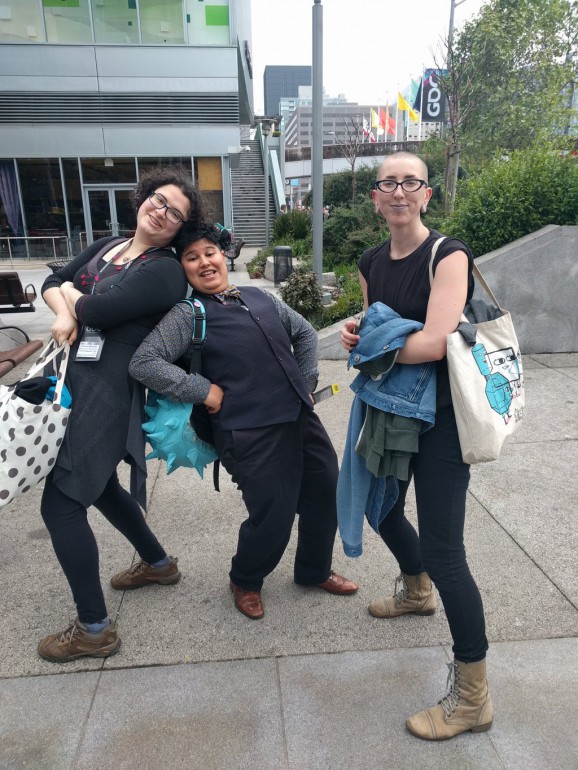
Last week I attended my first ever Game Developer’s Conference alongside what occasionally felt like at least half of the Montreal games people I know. It is a strange and wonderful feeling to run into folks from your city in one that is completely new to you. During GDC, this seemed to happen all the time.
I went a little early and stayed a little late, so while I was in San Francisco I also got to see a sea lion giving birth, go to a mirror maze, visit the Musee Mecanique and try all of its fortune telling cabinets, and go to the lovely San Francisco botanical gardens where a squirrel climbed up my leg (given today’s weather, I’m especially missing how GREEN San Francisco was).
For most of my time in San Francisco, I stayed with veteran GDC goer Squinky (who will soon be starting their PhD at TAG — and we’re lucky to have them around the lab with us already). This was Squinky’s eighth GDC, and they were kind enough to both find me a place to stay with a friend of theirs and to help me through what would no doubt otherwise have been a completely different experience.
The talks were excellent – as Gina has already mentioned, the TAG twitter feed is full of live-tweetin’s and retweets from the panels that we attended. Some of my favourites were Renee Nejo’s talk called “Everyone’s Silent Enemy: Shame and Vulnerability” which candidly explored her experience as a First Nation’s woman who has often felt “not native enough” in the estimation of others. No summary can do this particular talk justice, so I’ll point you towards the talk information, and hopefully you’ll be able to check it out on the vault: http://schedule.gdconf.com/session/everyones-silent-enemy-shame-and-vulnerability
It was really heartening for me to be able to watch Rebecca Cohen-Palacios, Stephanie Fisher, Sagen Yee, Zoe Quinn and Gemma Thomson deliver “Ripple Effect: How Women-in-Games Initiatives Make a Difference” — the Pixelles program is the reason that I made my first solo game and how I discovered that making games of my own was a viable possibility. The program was life-changing for me! This talk explored how such programs can ripple out, starting from the Difference Engine Initiative, where many of the speakers made their first games.
@inspectorbeans @RaygunGoth @rebheartsyou pic.twitter.com/Vkynjcwaev
— IDA (@idamarietoft) March 17, 2016
Our own Ida Toft delivered what I (perhaps biasedly, as one of this summer’s co-directors) thought was an excellent talk about Critical Hit 2015 and our experiences trying to build a safer space within the program. After Ida spoke about their take on the issues that made this very challenging, Ida invited Gina and I up, and the three of us took questions for the remaining half hour. We also invited some of the Critical Hit participants from this past year who attended the talk to give us their input as well. I was reminded that Safer Space isn’t a perfect solution, but that we have to keep trying and working towards something.
Speaking of this year’s Critical Hit participants, quite a few of them made it to GDC this year. They’re sharing their work and doing well – last fall we also saw quite a few of them at IndieCade! We managed to meet up for dinner with Kailin, Amanda, Hope, Nicole and Owen. A few of them will also be at the upcoming Different Games, so if you’re headed there, you should say hi to them!
Attending my first ever Lost Levels was also an oasis in the desert — it had a very different feel than the rest of the bustling conference, and I was able to relax for the first time that afternoon since the beginning of the conference. I listened to people talk about AI, led by the amazing Kate Compton (creator of the Tracery library, which I’m about to learn), was serenaded by impromptu music, including a live Gameboy chiptunes performance, and listened to an indie rant or two. All the while, I also ran the first ever Lost Levels Nap Summit, discussing important nap-related issues — did you know, for example, that casual naps are still naps? The Mild Rumpus, a carpeted “quieter” space within GDC with bean bags, pillows, trees, and experimental indie games, wasn’t quite mild enough for such discussions, as it turns out.
Squinky’s talk on Friday, “Designing Discomfort,” was brilliant – suggesting that maybe the flow state isn’t always ideal because it limits the kinds of stories we can tell. We should break out and explore possibilities outside of it, including more mature subject matter and more kinds of stories.
Perhaps unsurprisingly, while I enjoyed many excellent talks, some of my most worthwhile interactions at GDC happened at the peripheries of the event, because of the fact that for this week, thousands of game developers are sharing the same location. It was during lunch and dinner meetups and coffee breaks, during accidental meetings in the city or in hallways. I met a lot of lovely people, many of whom were introduced to me by Squinky.
You should also check out Gina’s excellent summary of the microtalks, which I also attended and appreciated.
